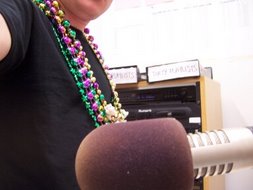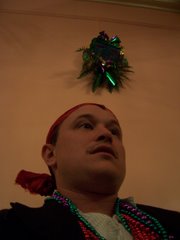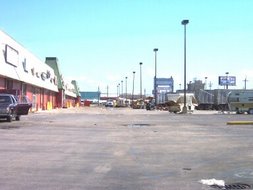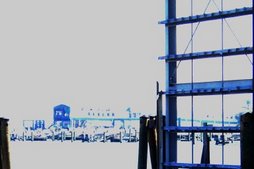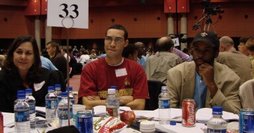
The barrier is almost gone now. Last week the bulldozers began to move and the dividers were spread wide enough for cars to pass between them. Now a large pit of sand takes up the intersection, with cones in the middle and two piles of dirt on either side of Magazine, so that for a little longer, the block is closed. The lake side of Melpomene was laid with a tarp, then filled in with more sand, and a proper Road Closed sign sits at the end facing Camp St.
I sat down there on a concrete slab and stared towards the river, a large pile of dirt blocking my view, the West Indians/Africans visible in their front yard, the normal drifters crossing the parking lot. As so often, every kind of cloud spread across the dusk, high and low and speaking of the ocean, and I heard faint shouting. One atop the other, the two billboards peeled further, decaying into a collage of bygone advertisements perhaps set up when the barrier first arose.
A white man in a tie rode by on a bicycle, then a black woman in tight jeans rode by on a bicycle, then a white girl on a moped crossed the barrier and parked. She entered the house next to the hoarders with their porch full of refuse and their junkyard dogs. As I chucked pebbles into the sand, a black man in a tank top and shorts walked up to other side of the barrier, a cell phone in his ear. He looked across at me but spoke into the phone, “Well, when you think you gonna be home, then?”
We wander through states of change all day long in this city, all of us. Some changes we notice, some we lament, some we applaud, a whole lot we never notice; each of us has our path and our position. When we come upon a change in the landscape, the distinctions might be: benign/malignant, positive/negative, due-to-the-storm/unrelated or only exacerbated-by-the-storm. Or, at least we hope there’s a distinction, any parcel of understanding, and realize its our job to search for an understanding, as citizens of a city undergoing intense change. When the future is wholly unknowable and you’re unmoored from so much of the past, every little corner holds potential clues.

Since we moved here, I felt a basic attraction to the barrier. Kim and I said it to each other right when we got here—we wanted to see that barrier stay. Instead of the choked throughway that is Magazine Street between Washington Avenue and Louisiana Avenue, we essentially have a long cul-de-sac. Along with the school across the street, its playground empty after 5pm, the neighborhood is almost always tranquil.
A block down from us, the barrier is a clearing, a gap in the world, where no cars can travel, where the weeds surround ancient brick walls and men with oddly-shaped heads sit under street lamps, a rusting RV squats in the mechanics’ parking lot, and the mechanics’ shed is painted gold, red, black, and green, with a palm tree as its logo.
Perhaps because the street is sunken, there’s a sense that you’re on an island or in a hole, caught in the traction of a secret, safe to light up or paint over or break things. It feels like the scene of an unsolved crime, or proof of a mistake that went uncorrected, and so what? The barrier predates the storm, was abandoned for its own reasons, and for a long time it felt ownerless, unhinged, and squalid, like a tropical Saturn or a lunar Lagos.

On our block, we’ve witnessed armed robbery and murder, bizarre forms of prostitution, and the general traffic and commerce of the neighborhood flophouse. Some people claim that the shadowy divide in the street caused the proliferation of shifty activity, including the chop shops and the squatters, as if this neighborhood was somehow upstanding before the barrier ruined everything.
That’s of course bullshit, despite the laments of people like the whiny prick next door, who waters his overstocked lawn two hours after a rainstorm and parks his Escalade next to the house he’s equipped with a marble front porch, from which the chirps of his two wiener dogs punctuate his grotesque, disgruntled, homeowner’s-rights fantasy-investment mansion.
Along with whatever other pathologies he harbors in his air-tight palace, there’s a pea of truth in his mattress: the division of this stretch of Magazine Street has blocked the all-important commercial development that has forcibly ambled downriver over the last decade, smiling robustly as the dive bars and furniture stores shut down, and only temporarily halted by the bursting of a water main and the collapse of two houses almost five years ago.
The consumptive joy-couture suckled by the wealthy along most of the street can’t travel any further with that goddamned barrier blocking its way, fucking shit, ok? There are hair salons, bistros, and property values at stake, alright? Shit, it’s just typical New Orleans that such a dumb thing could cost so much money….
By persisting, the barrier demonstrates all the reasons the city didn’t become a sultrier San Francisco a long time ago. Instead of taking advantage of our assets, we’ve allowed them to rot, and crime has sprung up, even after the projects were torn down and the problem was solved.
(Oh, and please ignore the swathe of deserted, pseudo-lofts along Annunciation, models for the great condos-to-come we read about (some apparently with bated breath). Don’t give second thought to the poor of the projects we shipped down river to drown in New Orleans East. No, catering to the leisure class, it just works out for the best, get fucking with it!)

We could’ve had more gelato joints; instead we have an old drunk limping past, not harming anyone, just boozing vacant-eyed through his own lonesome life, but certainly not “contributing,” not in the way Escalade conductor does. Maddening, uncooperative New Orleans, shooting itself in the foot—that’s the barrier to a lot of people.
Point taken. Proceed with normal traffic patterns.
And where do all these things go? Those abrasive hoarders will be ordered to dismantle, they’ll be found out and sanitized away, dogs and bile and kittens and piles of board and broken stereos along with them, to god knows where. Glorified slumlords like mine will buy more property, drive up rents, and then no more teenagers playing football and hip-hop in the street, no more new cars pulling into the chop shop, no more spooky fellows in front of the bookstore, no more stray dog in steady trot, balls still attached and swinging in the breeze. With the barrier open, the salon will flourish, a new coffee shop will open across the street, and our neighbor will have his latte. No one will even remember the barrier, and maybe someday all the dirt and dirty people will be gone for good.
That is progress. Increased tax revenue, fewer hookers screaming below our balcony (although the old orphanage on Race St. is hanging quite tough, dear neighbor). I only wonder what else goes with them. Maybe I overstate the barrier’s importance; maybe it’s romantic to think that danger and shadow and the illicit still have a place in this city, still contribute more than they steal, may even mean more than a well-designed lounge. I want us to squash the violence, the inequity, the idiocy, I really do. But I’d like to know what we’re getting in the trade.

How can the removal of the barrier help everyone, not just the designer sunglass-ed drivers of retail commerce and safety? When did those things take control of New Orleans? Who said that’s what we should all want? Why is the unprofitable expendable? Why is the weird and illogical now not a part of this city? Can we afford to lose any of it?
When I was down there last night, the dusk bathed the barrier in purple and gold. The battery on my camera went dead before I could capture those moments, so I just sat there on that concrete slab and let the evening play out in front of me, with its riders and callers and bums. Tonight we walked in muddy sand under a gray sky, the bulldozers asleep for the night but well positioned for tomorrow.
Two puppies, the spawn of the West Indians/Africans’ rough mutts, played in the dirt piles, tumbling over each other and barking at us. Kim said she thought the upper billboard carried a fairly new slogan, but I said, no, that couldn’t be. “Why would anyone have advertised here?” And if we walk down there tomorrow, more questions, more shifting sand, more signs to read, more change to ponder.
We know where we are when we are at the barrier, but tomorrow more of what was will be gone. I wonder where we’ll be then.











